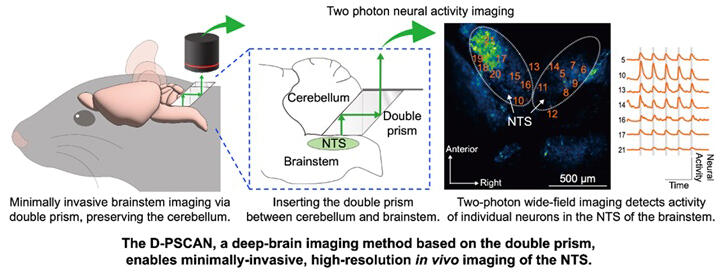Associate Professor Masakazu Agetsuma and former Director-General Junichi Nabekura of the Division of Biophotonics, National Institute for Physiological Sciences (NIPS), along with Lecturer Daisuke Yamada of the Faculty of Pharmaceutical Sciences, Tokyo University of Science, and Visiting Researcher Masayuki Sekiguchi of the National Center of Neurology and Psychiatry, announced their success in visualizing information passing through the nucleus tractus solitarii (NTS) in the brain stem, which connects the brain and body. They developed a new deep-brain imaging method called "D-PSCAN" that enables recording of neural activity in the NTS while maintaining cerebellar function in the living mouse brain. This technology is expected to be applied to clinical applications such as treatment-resistant depression. Their findings were published in the international scientific journal Cell Reports Methods on April 5.

The brain is connected to multiple organs through the vagus nerve, which has been found to affect emotions (feelings of joy, anger, sadness, and pleasure) and related emotional memories. One of the important sites where the vagus nerve transmits information is the NTS in the brain stem. In this region, information from many organs is first consolidated and then transmitted to various parts of the brain involved in emotional control. However, since the NTS is located deep within the cerebellum, detailed observation in a living state has been difficult, and the mechanism remained unclear. Since the cerebellum is important not only for motor control but also for emotional regulation, a method to observe the NTS while maintaining cerebellar function has been needed.
To address this challenge, the group developed the D-PSCAN (Double-Prism-based brainStem imaging under Cerebellar Architecture and Neural circuits) method. Through this method a double prism combining two 2-millimeter glass right-angle microprisms is implanted in the gap between the cerebellum and brain stem of a living mouse. This allows high-resolution visualization of the NTS behind the cerebellum across a wide field of view without cutting the cerebellum's neural connections.
In experiments, the group successfully recorded neural activity in the NTS while maintaining cerebellar function in the living mouse brain. When they electrically stimulated the vagus nerve and observed in detail the response of neurons in the NTS to this stimulation, they were able to observe complex responses specific to each neuron.
To observe the NTS in a more natural state than with electrical stimulation, they also used this method to observe the response when administering intestinal hormones secreted after meals. As a result, they were able to detect the activity of neurons in the NTS induced by intestinal hormone administration. The role of the NTS is also attracting attention in research fields such as diet, metabolism, and gut microbiota, and applications of this research are anticipated.
Agetsuma said: "The connection between the brain and body is involved in the control of the mind, and its regulation is expected to lead to the treatment of neuropsychiatric disorders. The NTS provides clues to clarify the relationship between brain, body, and mind. However, since it is located deep in the brain, detailed research has been difficult until now. The new observation technology developed in this collaborative research greatly advances our understanding of the NTS and is expected to be used in a wide range of fields from basic medical science to clinical applications."
Journal Information
Publication: Cell Reports Methods
Title: Minimally invasive, wide-field two-photon imaging of the brainstem at cellular resolution
DOI: 10.1016/j.crmeth.2025.101010
This article has been translated by JST with permission from The Science News Ltd. (https://sci-news.co.jp/). Unauthorized reproduction of the article and photographs is prohibited.




